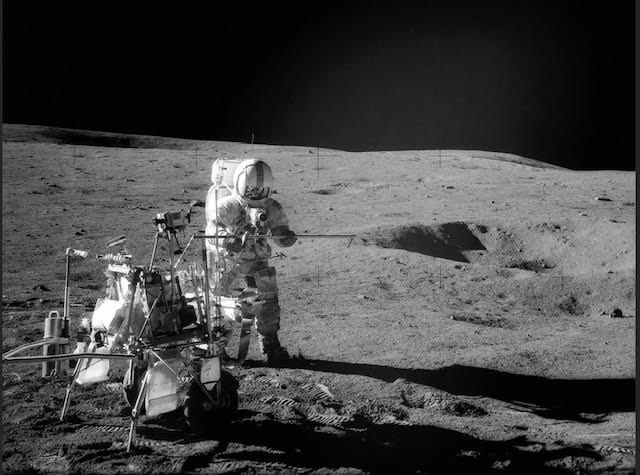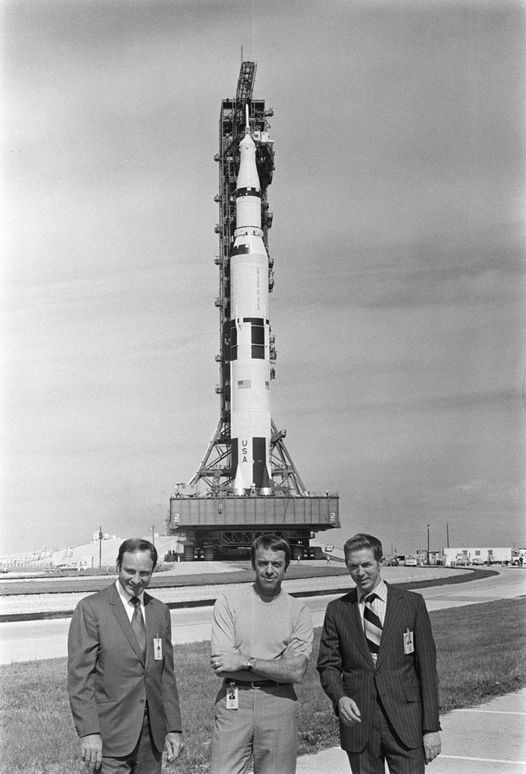Apollo XIV – Straight As a Die and Flying Right – 50th Anniversary


Alan Shepard’s triumphant return to outer space on Apollo 14 after ten years since his historic flight in the Mercury program was remarkable. Despite having been diagnosed with an inner ear infectious disease which grounded him, he continued in the space program as NASA’s Chief Astronaut. He also had part of his thyroid removed after doctors discovered a lump there in 1964. But fortunately he was able to return to full flight status in May of 1969 after having a surgical procedure done to correct the buildup of fluid in the ear.
Shepard would join the Apollo flight rotation and would get to command the third successful lunar landing in February of 1971. The Commander (pictured here at center) would be joined by Command Module Pilot Stuart Roosa (right), and Lunar Module Pilot Edgar Mitchell (left) who were all originally slated for Apollo 13 but were reassigned due to what was deemed as the crew’s inexperience to go to the Moon too soon.
Despite weather problems at launch on January 31st and constant technical difficulties during every phase of the trip to the Moon, Apollo 14 was a success. After a 40 minute delay caused by clouds and rain over Cape Kennedy, Apollo 14 finally lifted off at 21:03 Universal Time.
One of the biggest problems they experienced were the several attempts made to connect the command module, Kitty Hawk, to the lunar module, Antares. They tried to dock the two vehicles five times unsuccessfully, but finally the crafts latched firmly together on the sixth try. The launching delay and the docking problem caused most events to run well behind schedule.
Another delay was caused by an accidentally opened circuit breaker that cut off Moon-to-Earth communications, which caused a delay of about 50 minutes before the astronauts could emerge to walk on to the lunar surface. All of these minor problems cost the astronauts much time.

Astronaut Alan Shepard wheeled around a cart loaded with tools and equipment, much like a golf cart carrying golf clubs. A seismic experiment was devised in which a remote control motor would fire grenades on command from Houston control. After the ASLEP experiment package and laser retroreflector (LRRR) were setup, their first excursion would be a walk around a nearby doublet crater.
On the second day after a four hour sleepover, they would make the one mile hike to Cone Crater, but they didn’t quite reach their destination because of the extreme slope to the crater rim— it was 330 feet higher than expected. As a result, no studies were made of the inside of the largest crater ever to be approached on any of the lunar missions.
And despite improvements made to the TV camera to prevent another burnout from the Sun (like what happened on Apollo 12), some of the camera angles were not conducive to home television viewing and I’m sure didn’t sit well with the major networks. For example, one Apollo 14 camera angle had only given a long, long look of the two astronauts walking into the brilliant Sun, along with their tracks glistening as they dragged their cart towards Cone Crater. So not much could be seen, which probably didn’t help viewership at home.
Having landed on February 5th, it was soon time for the crew to leave after being on the Moon for nearly thirty-four hours. As the two spacecraft met in lunar orbit, there were concerns about the docking mechanism that gave them problems at the start of their sojourn. Fortunately there were no issues.
Apollo 14, upon its return home on February 9th, would be the last crew to be put into three week isolation quarantine (something we are familiar with in 2021). Interestingly, there was a Lunar Eclipse as seen from Earth that night. How grand it would have been to witness that same event from the lunar surface! Maybe someday soon.
| Launched | Landed on the Moon | Left the Moon | Returned to Earth | Lunar Eclipse |
|---|---|---|---|---|
| 1/31/71 | 2/5/71 | 2/6/71 | 2/9/71 | 2/9/71 to 2/10/71 |
A Nice Day for a Game of Golf: “Straight as a Die, Miles and Miles!”
In an attempt to give a demonstration of gravity on an alien world, Alan Shepard exhibited the game of golf at 1/6 of Earth’s gravity. This gives him the distinction of not only being the first American in space but also the first human to golf on another world. Here is a script of the conversation:
Shepard: Houston, while you’re looking that up, you might recognize what I have in my hand as the handle for the contingency sample return; it just so happens to have a genuine six iron on the bottom of it. In my left hand, I have a little white pellet that’s familiar to millions of Americans. I’ll drop it down. Unfortunately, the suit is so stiff, I can’t do this with two hands, but I’m going to try a little sand-trap shot here.
Houston (Haise): That looked like a slice to me, Al.
Shepard: Here we go. Straight as a die; one more. (Long Pause)
(His third swing connects and travels on a low trajectory to the right. He drops another ball and hits it along a similar path.)
Shepard: Miles and miles and miles!
https://www.hq.nasa.gov/alsj/a14/a14.html; https://www.hq.nasa.gov/alsj/a14/a14.clsout2.html

Oval Office Moon Rock Display
By Robert Z. Pearlman, 1/22/21
https://www.space.com/president-biden-moon-rock-oval-office (full article link.)
President Joseph Biden and the lunar sample 76015,143 will now share the Oval Office. The Biden Administration requested an Apollo-recovered moon rock for display as, “a symbolic recognition of earlier generations’ ambitions and accomplishments, and support for America’s current Moon to Mars exploration approach.
A descriptive plaque on the base of the White House moon rock display explains that the 3.9-billion-year-old sample was chipped, “from a large boulder at the base of the North Massif in the Taurus-Littrow Valley” by Apollo 17 astronauts Eugene Cernan and Harrison Schmitt, the last (to date) humans to walk on the Moon.
Cernan and Schmitt, together with command module pilot Ron Evans, returned the sample, and others like it, to Earth on Dec. 19, 1972 (lunar sample 76015 was collected 6 days earlier on Dec. 13, 1972).
Sources:
Sky and Telescope, April 1971 issue, Vol.41 #4 Apollo 14’s Moon Mission.
New Worlds for Old, Duncan Lunan © 1979.




